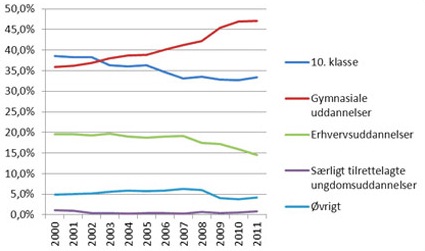Another positive step towards the 95-percent target
 "Specially organized youth education" are both basic vocational education (EGU) and secondary schools for young people with special needs (USB). "Others" are for example production school, 10th school year, youth college, study abroad (including schooling) and employment. Almost 94 per cent of pupils leaving 9th grade - and do not go to 10th grade - and the students leaving 10 . class, seeking an education. Slightly more than in previous years has chosen to take the 10th grade with. The prospect of being assessed training readiness may have been the young people to think about one more time before they have sought education, which is the purpose of the assessment of students' learning readiness. Perhaps taking a slightly more realistic educational choices, or maybe there is some mathematics, the student must be better, so it is better to wait to enter the dream program. Education Minister Troels Lund Poulsen said: "I am pleased that virtually all leaving 9th and 10th grade, now know what they need after the summer and have a plan that will lead them to a secondary education. it helps that we reach our ambitious target that 95 percent of a year group complete a youth. "Education Readiness assessment is a result of the government's youth package II, which is put into effect from 1 January. With young Package II, it is responsibility of the municipalities that young people aged 15-17 are ready to start and complete a secondary education. There are widespread communal differences in the proportion of pupils who are not deemed education prepared. The five municipalities with the highest number of pupils assessed non-training prepared the Zealand municipalities Albertslund, Ishøj, Ringsted, Roskilde and Brøndby in Copenhagen just after, while the five bottom are the four island municipalities and Glostrup, who did not have pupils registered with the assessment non-training readiness. "It is gratifying that the municipalities assume enhanced responsibilities for the 15-17-year-olds, although these must first be observed large municipal differences in the assessment of students' learning readiness," says Troels Lund Poulsen. "This relationship will government of course follow up on the evaluation of the system, and I have written a letter to the country's mayors, where I have stressed local authorities' new obligations imposed by young package II. "statement shows a continuing decline in the search directly from the 9 and 10 . class for vocational education. It suggests that vocational education is increasingly seen as training for adults or at least for those with some experience. "The negative trend gives rise to consider the need for a fundamental change of VET function in the overall education system. Therefore, the Government has also initiated a 360-degree inspection of vocational training, " says Troels Lund Poulsen. Read more about the development of young people's search pattern and on the assessment of training readiness: Changes in the proportion of young people who have a secondary education development in the search pattern and the preliminary results of the assessment of training readiness Source: UVM.dk
"Specially organized youth education" are both basic vocational education (EGU) and secondary schools for young people with special needs (USB). "Others" are for example production school, 10th school year, youth college, study abroad (including schooling) and employment. Almost 94 per cent of pupils leaving 9th grade - and do not go to 10th grade - and the students leaving 10 . class, seeking an education. Slightly more than in previous years has chosen to take the 10th grade with. The prospect of being assessed training readiness may have been the young people to think about one more time before they have sought education, which is the purpose of the assessment of students' learning readiness. Perhaps taking a slightly more realistic educational choices, or maybe there is some mathematics, the student must be better, so it is better to wait to enter the dream program. Education Minister Troels Lund Poulsen said: "I am pleased that virtually all leaving 9th and 10th grade, now know what they need after the summer and have a plan that will lead them to a secondary education. it helps that we reach our ambitious target that 95 percent of a year group complete a youth. "Education Readiness assessment is a result of the government's youth package II, which is put into effect from 1 January. With young Package II, it is responsibility of the municipalities that young people aged 15-17 are ready to start and complete a secondary education. There are widespread communal differences in the proportion of pupils who are not deemed education prepared. The five municipalities with the highest number of pupils assessed non-training prepared the Zealand municipalities Albertslund, Ishøj, Ringsted, Roskilde and Brøndby in Copenhagen just after, while the five bottom are the four island municipalities and Glostrup, who did not have pupils registered with the assessment non-training readiness. "It is gratifying that the municipalities assume enhanced responsibilities for the 15-17-year-olds, although these must first be observed large municipal differences in the assessment of students' learning readiness," says Troels Lund Poulsen. "This relationship will government of course follow up on the evaluation of the system, and I have written a letter to the country's mayors, where I have stressed local authorities' new obligations imposed by young package II. "statement shows a continuing decline in the search directly from the 9 and 10 . class for vocational education. It suggests that vocational education is increasingly seen as training for adults or at least for those with some experience. "The negative trend gives rise to consider the need for a fundamental change of VET function in the overall education system. Therefore, the Government has also initiated a 360-degree inspection of vocational training, " says Troels Lund Poulsen. Read more about the development of young people's search pattern and on the assessment of training readiness: Changes in the proportion of young people who have a secondary education development in the search pattern and the preliminary results of the assessment of training readiness Source: UVM.dk 


